
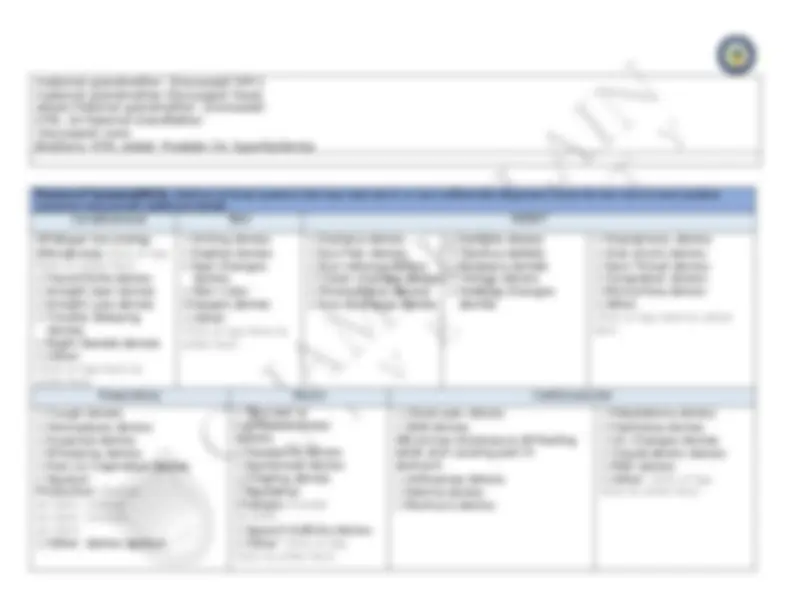
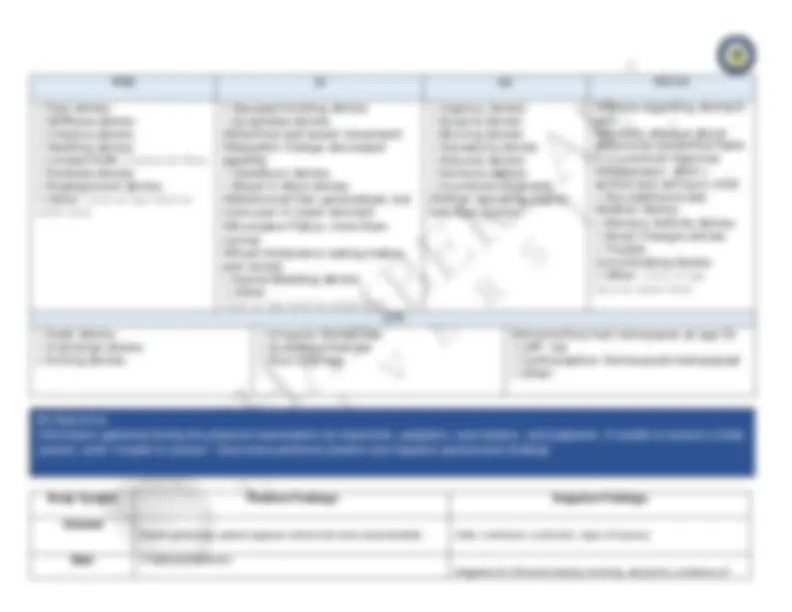
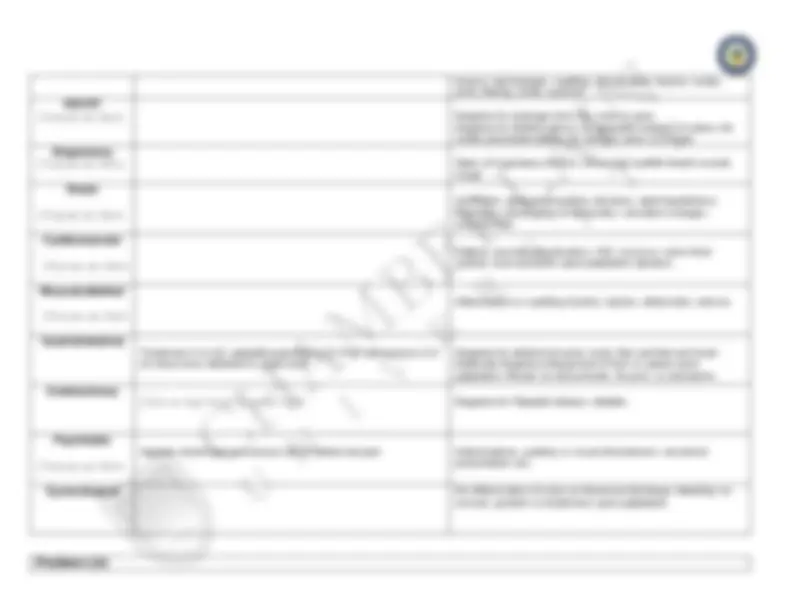
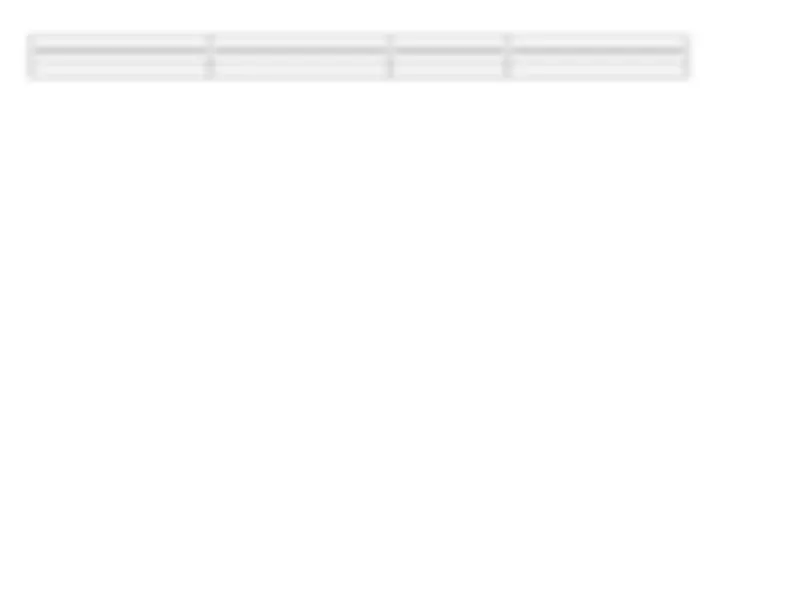
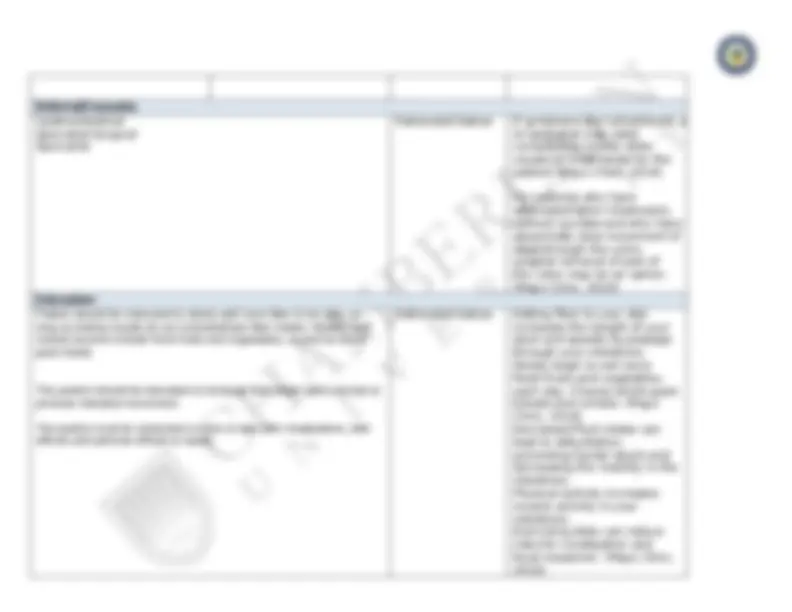
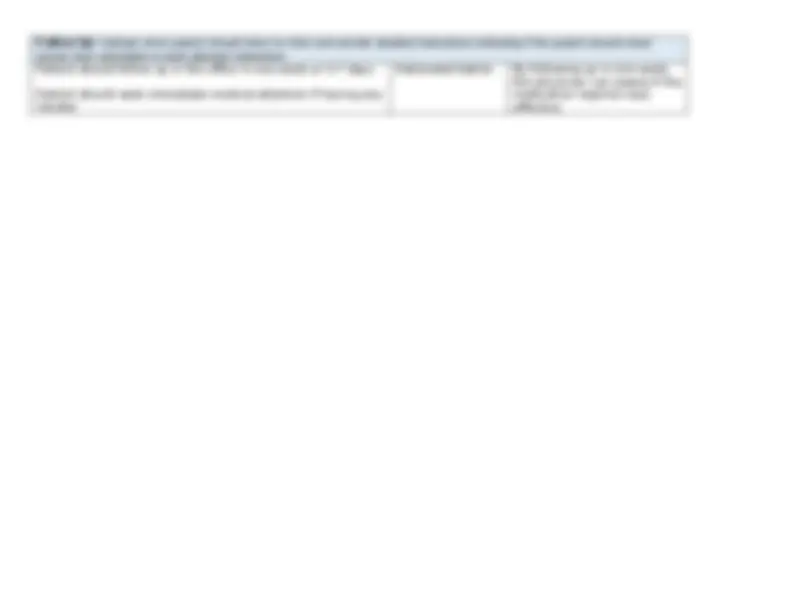


Study with the several resources on Docsity

Earn points by helping other students or get them with a premium plan


Prepare for your exams
Study with the several resources on Docsity

Earn points to download
Earn points by helping other students or get them with a premium plan
Community
Ask the community for help and clear up your study doubts
Discover the best universities in your country according to Docsity users
Free resources
Download our free guides on studying techniques, anxiety management strategies, and thesis advice from Docsity tutors
NR509 SOAP Note Abdominal Pain week 5 - Copy.docx
Typology: Exams
1 / 11

This page cannot be seen from the preview
Don't miss anything!







Initials: EP Age: 78 Gender:Female Height Weight BP HR RR Temp SPO2 Pain Allergies 5’2” 120lb 110/ 70 92 16 37.0C 99% 6/10 Medication: none Food: none Environment: Latex: S/S: rash/ pruritis History of Present Illness (HPI) Chief Complaint (CC) “Belly Pain” “Trouble going to the bathroom” (^) CC is a BRIEF statement identifying why the patient is here - in the patient’s own words - for instance "headache", NOT "bad headache for 3 days”. Sometimes a patient has more than one complaint. For example: If the patient presents with cough and sore throat, identify which is the CC and which may be an associated symptom O nset 5 days; Unsure of cause; L ocation Whole belly, but mostly in lower stomach D uration Consistent for the past 5 days, worsened in the past 2- 3 C haracteristics Dull and crampy; feeling of being tired and weak, constipation, diarrhea A ggravating Factors Activity; eating; R elieving Factors Rest, avoiding meals T reatment Rest, sips of warm water Current Medications: Include dosage, frequency, length of time used and reason for use; also include OTC or homeopathic products. Medication (Rx, OTC, or Homeopathic) Dosage Frequency Length of Time Used Reason for Use Accupril 10mg PO Daily 24 years Hypertension Click or tap here to enter text. Click or tap here to enter text. Click or tap here to enter text. Click or tap here to enter text. Click or tap here to enter text. Past Medical History (PMHx) – Includes but not limited to immunization status (note date of last tetanus for all adults), past major illnesses, hospitalizations, and surgeries. Depending on the CC, more info maybe needed. Hypertension-diagnosed at age 54 Gallstones with cholecystectomy- age 42
C-section: age 42 Colonoscopy: History of 2; last, 10 years ago Last OB appointment: 3 years ago Last Pap smear: over 10 years ago Last eye exam: Unsure Dental Appointment: attends twice a year for cleaning; Attends PCP annually Up to date on all vaccinations/ immunizations Typical bowel regimen: Daily Social History (Soc Hx) - Includes but not limited to occupation and major hobbies, family status, tobacco and alcohol use, and any other pertinent data. Include health promotion such as use seat belts all the time or working smoke detectors in the house. Marriage Status: Widowed 6 years ago Children: 1 son and 1 daughter Lives with daughter; Available to assist with shopping and daily activities if needed Career: Retired registered nurse Hobbies: Gardening, taking walks, exercise classes, water aerobics, pilates and reading Alcohol use: Drinks one glass of white wine every Sunday Tobacco use: None Illicit drug use: None Exercise: attends community center for water aerobics and pilates; Walking Diet: Follows low fat diet; avoids caffeinated beverages; eats natural forms of fiber in the form of fruits and vegetables; skips breakfast and lunch on occasion Fluid intake: drinks on average 2 glasses of water a day; drinks chamomile tea Family History (Fam Hx) - Includes but not limited to illnesses with possible genetic predisposition, contagious or chronic illnesses. Reason for death of any deceased first degree relatives should be included. Include parents, grandparents, siblings, and children. Include grandchildren if pertinent. Husband: (Deceased at the age of 82); fall with brain bleed Children: 1 still born child; 2 living children: Son Timothy (48)-no health conditions; Daughter Jennifer (46)- no health conditions Mother: (deceased 88) DM II, HTN Father: (deceased 82)hyperlipidemia, htn, overweight
☐ Pain denies ☐ Stiffness denies ☐ Crepitus denies ☐ Swelling denies ☐ Limited ROM Choose an item. ☐ Redness denies ☐ Misalignment denies ☐ Other: Click or tap here to enter text. ☐ Nausea/Vomiting denies ☐ Dysphasia denies ☒Diarrhea last bowel movement ☒Appetite Change decreased appetite ☐ Heartburn denies ☐ Blood in Stool denies ☒Abdominal Pain generalized, but more pain in lower stomach ☒Excessive Flatus: more than normal ☒Food Intolerance eating makes pain worse ☐ Rectal Bleeding denies ☐ Other: Click or tap here to enter text. ☐ Urgency denies ☐ Dysuria denies ☐ Burning denies ☐ Hematuria denies ☐ Polyuria denies ☐ Nocturia denies ☐ Incontinence denies ☒Other: urinating slightly less than normal ☒Stress regarding stomach pain ☒Anxiety anxious about abdominal discomfort-feels it is a normal response ☒Depression- after c section and still born child ☐ Suicidal/Homicidal Ideation denies ☐ Memory Deficits denies ☐ Mood Changes denies ☐ Trouble Concentrating denies ☐ Other: Click or tap here to enter text. GYN ☐ Rash denies ☐ Discharge denies ☐ Itching denies ☐ Irregular Menses n/a ☐ Dysmenorrhea n/a ☐ Foul Odor n/a ☒Amenorrhea had menopause at age 54 ☐ LMP: n/a ☐ Contraception Denies;post-menopausal ☐ Other: Body System Positive Findings Negative Findings General Facial grimacing; patient appears distressed and uncomfortable; Odor; confusion; confusion; signs of trauma; Skin^2 scars^ on^ abdomen Negative for Wounds,tenting, bruising, abrasions, evidence of
trauma, nail changes, swelling, discoloration, lesions, moles, acne, flaking, striae, cyanosis HEENT Choose an item. Negative^ for^ drainage^ from^ ear,^ nose^ or^ eyes; Negative for Malformations; No apparent redness of sclera. No visible periorbital edema. No obvious ulcers on mouth. Respiratory Choose an item. Signs^ of^ respiratory^ distress,^ wheezing,^ audible^ breath^ sounds, cough Neuro Choose an item. Confusion, aphasia,dysarthria, dizziness, light-headedness, numbness and tingling of extremities; sensation changes, memory loss Cardiovascular Choose an item. Edema, vascular discoloration, JVD, murmurs, extra heart sounds, bruit and thrills upon palpitation ofpulses; Musculoskeletal Choose an item. Inflammation or swelling of joints, injuries, deformities, tremors Gastrointestinal Tenderness in LLQ, palpable guarding; LLQ: Firm oblong mass-2- cm.fecal mass detected in rectal vault Negative for abdominal aorta, renal, Iliac and femoral bruits bilaterally.Negative enlargement of liver or spleen upon palpitation; Rectal: no hemorrhoids, fissures, or ulcerations Genitourinary Click or tap here to enter text. Negative^ for^ Palpable^ kidneys,^ bladder; Psychiatric Choose an item. Appears distressed and anxious about abdominal pain Hallucinations, auditory or visual disturbances, emotional presentation, tics Gynecological No^ inflammation^ of^ vulva^ no^ Abnormal^ discharge,^ bleeding;^ no masses, growths or tenderness upon palpitation
Test Rationale/Citation Abdominal X-ray An x-ray can show if intestines are blocked and whether there is stool is present in the colon (Mayo Clinic, 2019) Colonoscopy Allows the physician to examine the entire colon with a flexible camera tube (Mayo Clinic, 2019) CBC, Thyroid testing A CBC can detail if the patient has any signs of infection that can be associated with the constipation, elevated Calcium levels, which can cause constipation, and electrolytes levels which can depict fluid status. Thyroid levels can also alter a patient’s bowel regimen, so thyroid testing may be beneficial in assessing the cause of constipation. (Mayo Clinic, 2019). Digital Inspection of Rectum If a fecal impaction is suspected, a physician may use manual disimpaction to free the hardened stool from the rectum (Larkin et al., 2018).
Drug Dosage Length of Treatment Rationale/Citation Metamucil (Psyllium) 0.4 gram capsule PO TID Continuous When taken on a continual basis, fiber can regulate bowel habits by increasing the bulk of stool, therefore stimulating the intestines to move stool more adequately, reducing constipation. (Harvard Health Publishing, 2019). Senna (Sennosides) 17.2mg tablet PO daily prn As needed (^) A stimulant laxative that causes the colon muscles to contract more frequently/ aggressively to expel feces and may be used on occasion for constipation. (Harvard Health Publishing, 2019).
sooner than scheduled or seek attention elsewhere. Patient should follow up in the office in one week or 5-7 days Patient should seek immediate medical attention if having any nausea Rationale/Citation By following up in one week, the physician can assess if the medication regimen was effective
and vomiting, worsening abdominal pain, fever, blood in stool, or adverse effects of medication. in treating the patient’s impaction and constipation. If the bowel regimen has not returned to normal, a surgical consult for further testing, such as a colonoscopy may be warranted. (Mayo Clinic, 2019).
Include at least one evidence-based peer-reviewed journal article which relates to this case. Use the correct APA 6th edition formatting. Harvard Health Publishing. (2019). Constipation and impaction. retrieved from: https://healthharvard.edu/a_to_z/constipation-and- impaction-a-to-z Larkin, P., Cherng, N., Carpia, D., Gugliemo, M., Ostgame, C., Scotte, F., &Ripamonti, C. (2018). Diagnosis, assessment and management of constipation in advanced caner: ESMO clinical practice guidelines. Annals of Oncology, 29(4), 111-125. doi: 10.1093/annonc/mdy Mayo Clinic. (2019). Constipation. retrieved from: https://www.mayoclinic.org/diseases-conditions/constipation/diagnosis- treatment/drc-